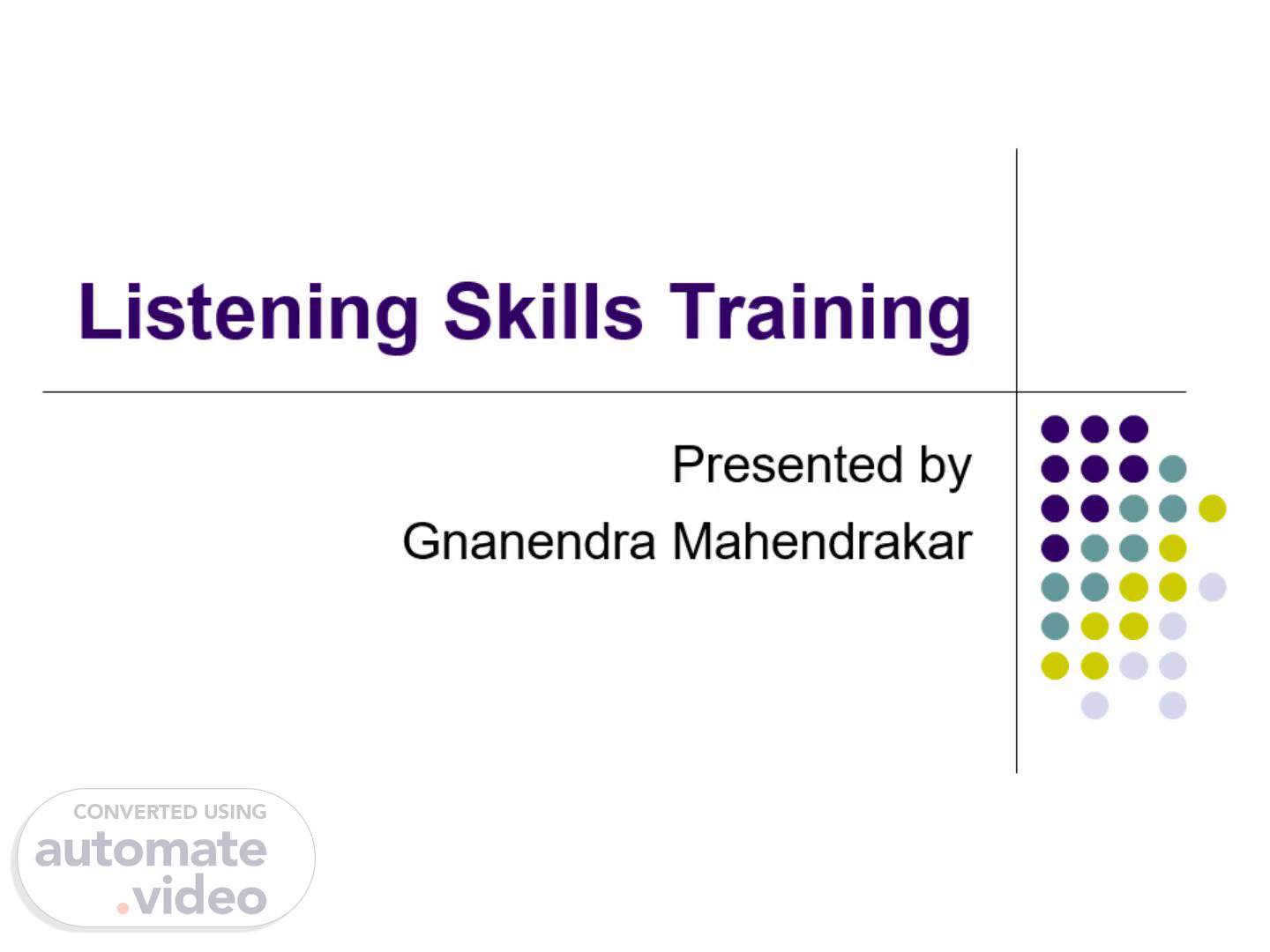Scene 1 (0s)
Listening Skills Training. Presented by Gnanendra Mahendrakar.
Scene 2 (6s)
Listening Skills. 1, Introduction to Listening Skills 2, Barriers to Effective Listening 3, Characteristics of a Good Listener 4, Developing Active Listening Skills 5, Overcoming Common Listening Challenges 6, Interactive Exercises and Activities.
Scene 3 (20s)
The most basic and effective way to connect with another individual is to listen to. Just listen. Perhaps the most important thing we ever give each other is our attention. Dr. Rachel Naomi Remen.
Scene 4 (32s)
Effective listening requires concentration and the use of your other senses – not just hearing the words spoken..
Scene 5 (41s)
1, Introduction to Listening Skills. Importance of Effective Listening • Impact on Communication • Building Stronger Relationships • Professional and Personal Benefits.
Scene 6 (51s)
Time Spend Communicating. Adults spend an average of 70 percent of the time engaged in some kind of communication..
Scene 7 (1m 1s)
1, Introduction to Listening Skills. B, Types of Listening • Active Listening • Reflective Listening • Empathetic Listening.
Scene 8 (1m 10s)
1, Introduction to Listening Skills. B, Types of Listening • Active Listening Active listening involves fully concentrating, understanding, responding, and remembering what is being said. It requires giving your full attention to the speaker..
Scene 9 (1m 22s)
1, Introduction to Listening Skills. B, Types of Listening • Reflective Listening Reflective listening involves empathetically summarizing a speaker's message to show understanding and encourage open communication..
Scene 10 (1m 32s)
1, Introduction to Listening Skills. B, Types of Listening • Empathetic Listening Empathetic listening is about understanding and sharing the speaker's feelings for a deeper connection..
Scene 11 (1m 44s)
II. Barriers to Effective Listening. Internal Barriers • Preoccupation Preoccupation hinders effective listening by diverting attention to personal thoughts, creating a barrier to understanding the speaker's message..
Scene 12 (1m 55s)
II. Barriers to Effective Listening. Internal Barriers • Personal Biases Personal biases hinder effective listening by influencing preconceived notions and leading to selective attention, potentially distorting the understanding of the speaker's message..
Scene 13 (2m 6s)
II. Barriers to Effective Listening. Internal Barriers • Emotional Distractions Emotional distractions disrupt effective listening by diverting attention from the speaker's message..
Scene 14 (2m 15s)
II. Barriers to Effective Listening. External Barriers • Noise and Environmental Distractions Environmental distractions, like noise, hinder effective listening by impeding the clarity of the speaker's message and disrupting focus..
Scene 15 (2m 27s)
II. Barriers to Effective Listening. External Barriers • Technology Interruptions Technology interruptions, such as phone notifications or digital devices, pose barriers to effective listening by diverting attention away from the speaker's message and diminishing the quality of communication..
Scene 16 (2m 39s)
II. Barriers to Effective Listening. External Barriers • Lack of Focus Not paying attention is a big problem for listening because it makes it hard to understand what the speaker is saying..
Scene 17 (2m 50s)
III. Characteristics of a Good Listener. Non-Verbal Communication • Eye Contact Eye contact is a nonverbal form of communication that involves making direct visual connections, conveying interest, confidence, and engagement..
Scene 18 (3m 3s)
III. Characteristics of a Good Listener. Non-Verbal Communication • Body Language Body language communicates feelings and thoughts through gestures, facial expressions, and posture without using words..
Scene 19 (3m 13s)
III. Characteristics of a Good Listener. Non-Verbal Communication • Eye Contact • Body Language • Nodding and Other Gestures.
Scene 20 (3m 21s)
III. Characteristics of a Good Listener. Verbal Communication • Asking Clarifying Questions • Paraphrasing • Summarizing.
Scene 21 (3m 27s)
IV. Developing Active Listening Skills. Paying Full Attention • Minimizing Distractions • Focusing on the Speaker • Avoiding Interrupting.
Scene 22 (3m 36s)
IV. Developing Active Listening Skills. Demonstrating Empathy • Understanding Others' Perspectives • Validating Emotions • Responding Appropriately.
Scene 23 (3m 44s)
IV. Developing Active Listening Skills. Providing Feedback • Offering Constructive Feedback • Seeking Clarification • Avoiding Assumptions.
Scene 24 (3m 51s)
V. Overcoming Common Listening Challenges. Handling Misunderstandings • Clarifying Misinterpreted Information • Addressing Cultural Differences • Confirming Understanding.
Scene 25 (4m 0s)
V. Overcoming Common Listening Challenges. Dealing with Emotionally Charged Conversations • Remaining Calm and Composed • Acknowledging Emotions • Refraining from Immediate Judgment.
Scene 26 (4m 8s)
Signing-off.
